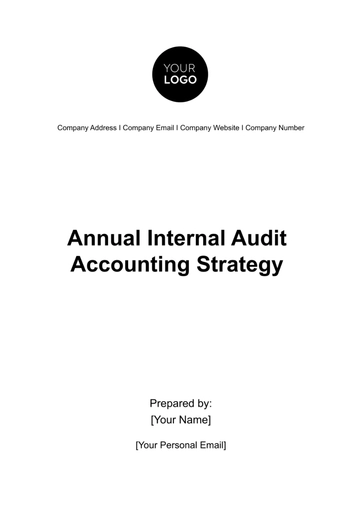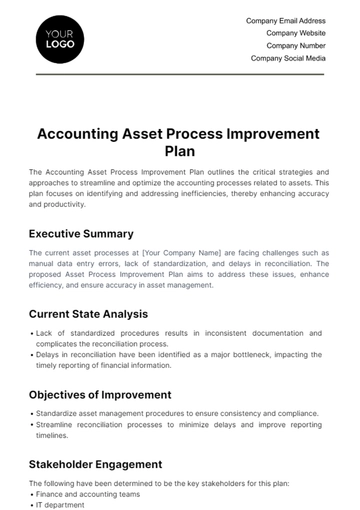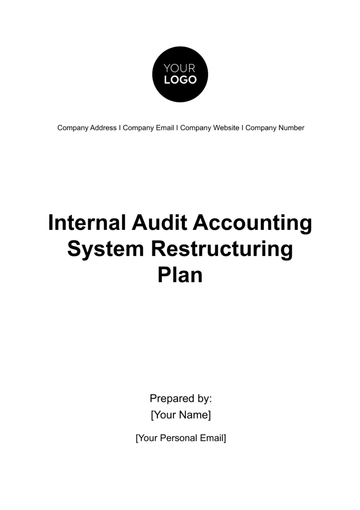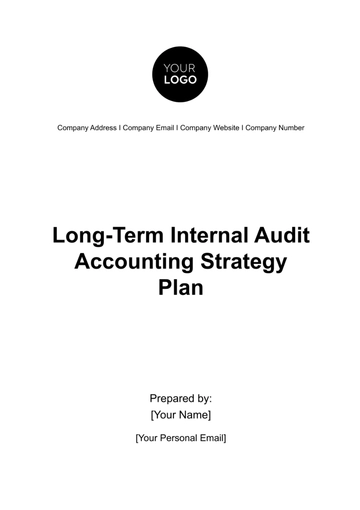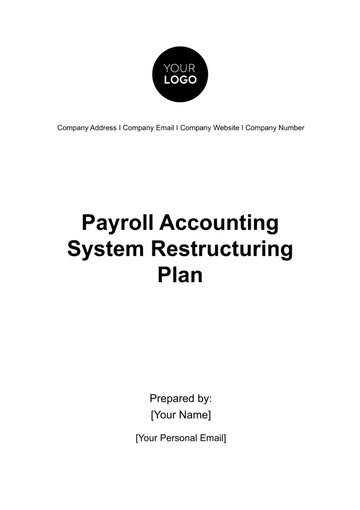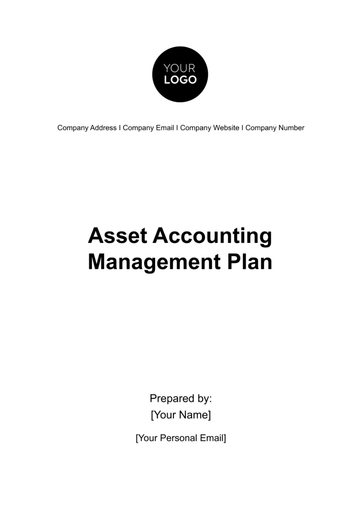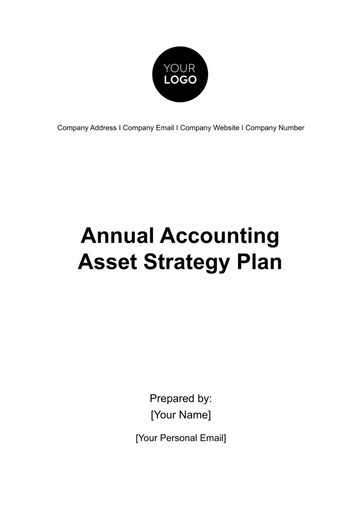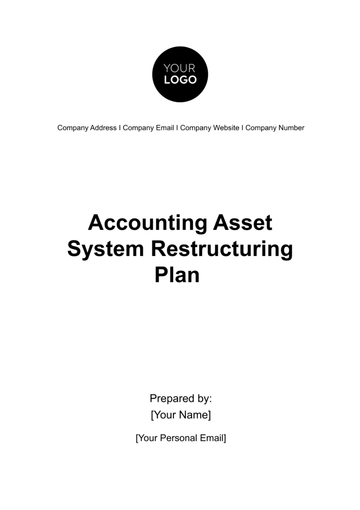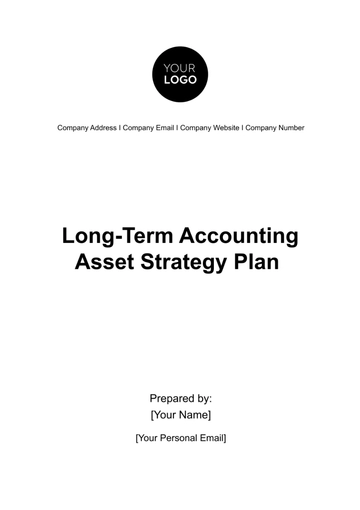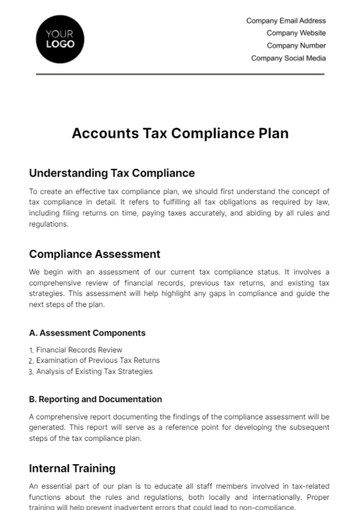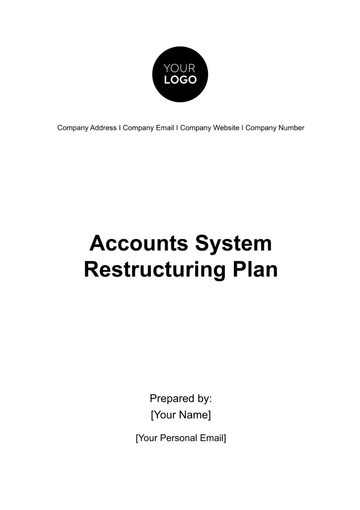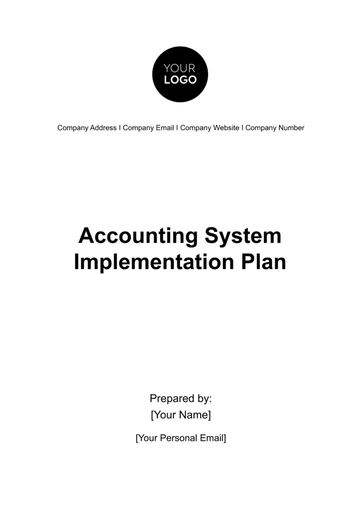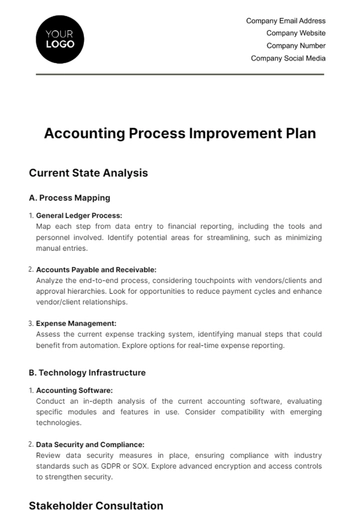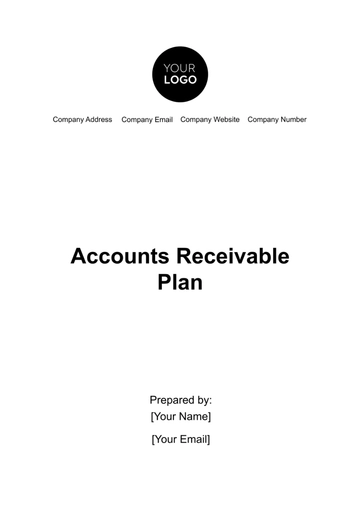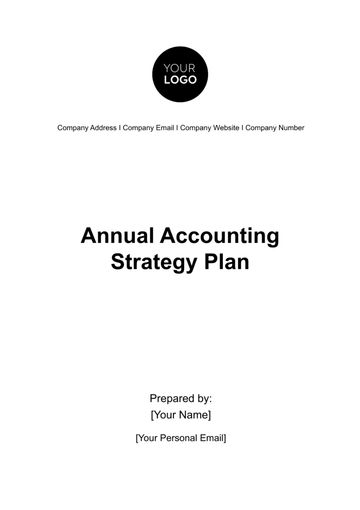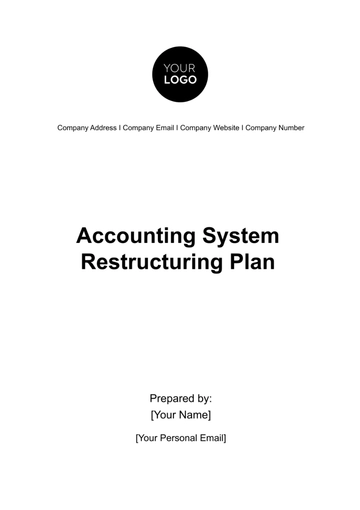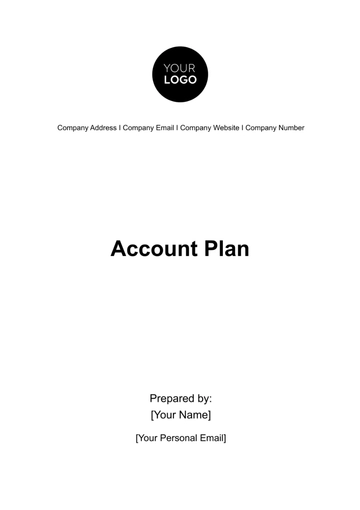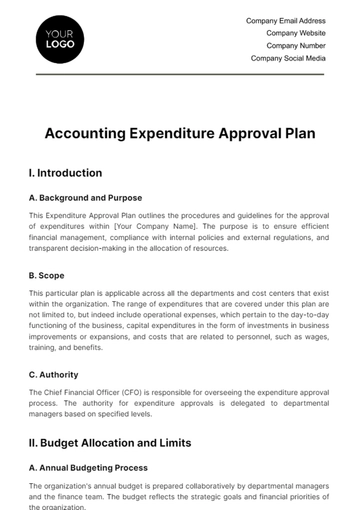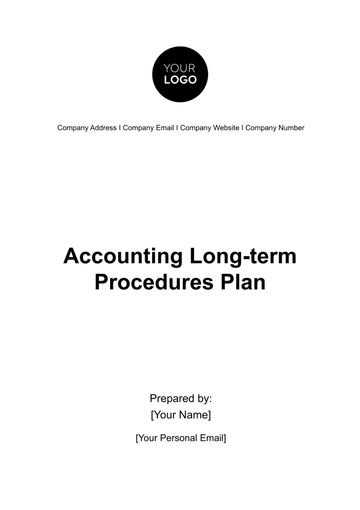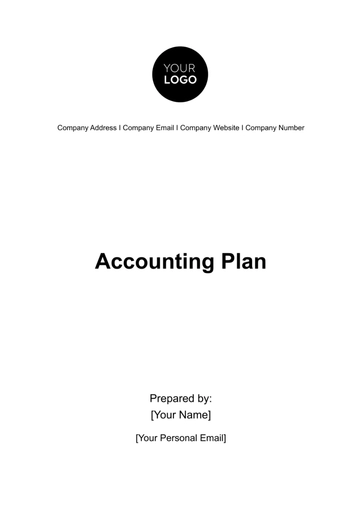Free Detailed Internal Audit Accounting Plan
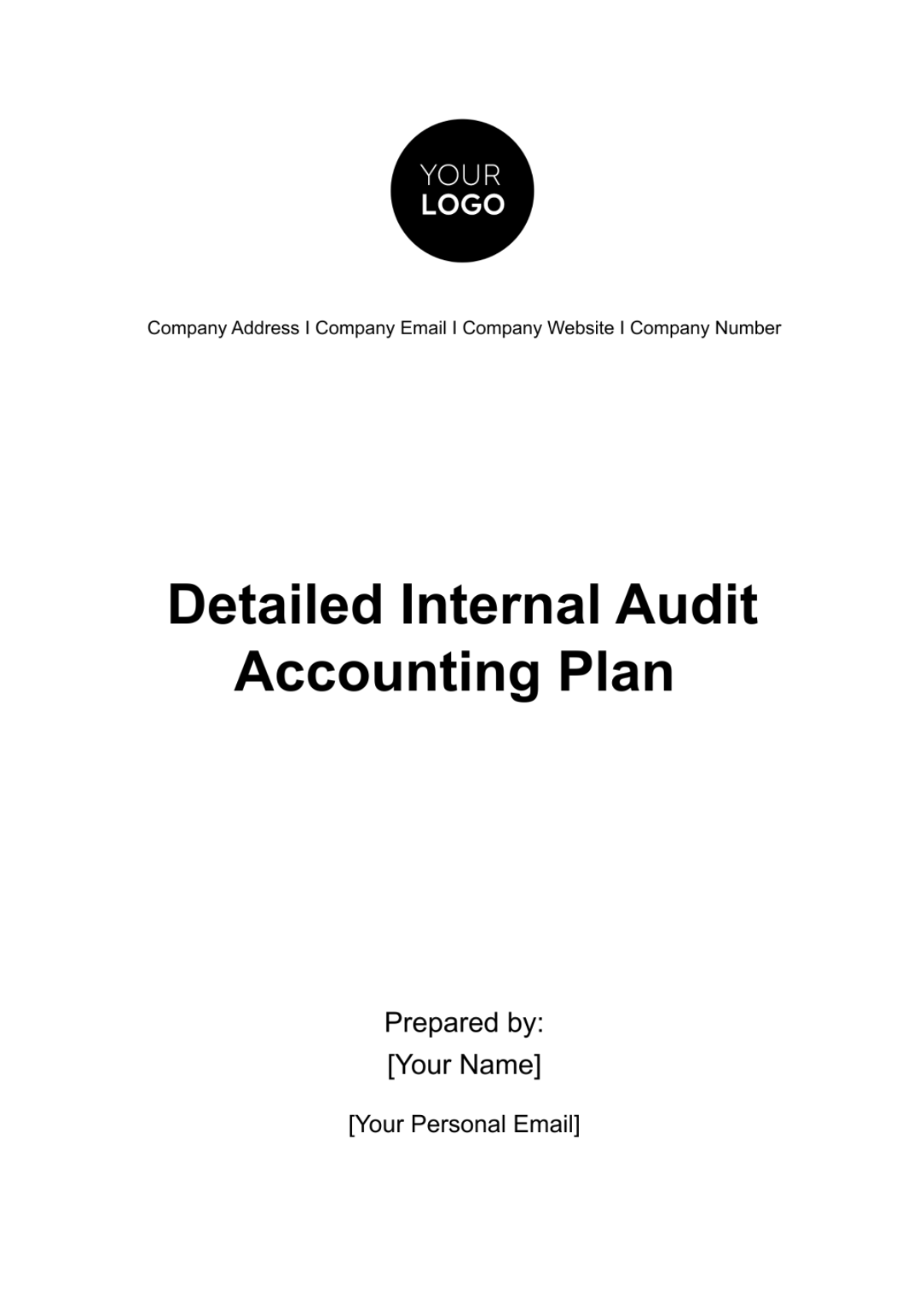
I. Introduction
A. Purpose of the Internal Audit Accounting Plan
The purpose of this Internal Audit Accounting Plan is to outline the comprehensive approach and procedures for conducting an internal audit of the financial processes and controls within [Your Company Name]. This plan aims to ensure the accuracy, reliability, and compliance of financial data, safeguard company assets, and identify areas for improvement.
B. Scope and Objectives of the Audit
The scope of this audit covers all financial aspects of [Your Company Name], including but not limited to revenue recognition, expense management, asset management, compliance with accounting standards (GAAP), and adherence to relevant financial regulations. The objectives of this audit are to:
Evaluate the effectiveness of internal controls related to financial processes.
Assess the accuracy and completeness of financial reporting.
Identify and mitigate financial risks.
Ensure compliance with accounting standards and regulations.
Provide recommendations for process improvement and risk mitigation.
C. Background Information on the Organization
[Your Company Name] is a leading manufacturing company specializing in the production of automotive components. With operations spanning multiple countries and a diverse product portfolio, the company generates substantial revenue and faces complex financial challenges. This audit aims to support the organization's commitment to financial transparency and compliance.
D. Identification of Key Stakeholders
Key stakeholders involved in this audit include:
CEO and senior management
Chief Financial Officer (CFO)
Finance and accounting teams
Internal Audit Department
External auditors (as needed)
Regulatory bodies (as applicable)
II. Audit Planning
A. Establishing the Audit Team
The audit team for this engagement is composed of experienced professionals from the Internal Audit Department and may include external experts as required. Roles and responsibilities within the team are defined as follows:
ROLE | RESPONSIBILITIES |
|---|---|
Audit Team Leader | Overall project management, supervision of audit activities |
Senior Auditor | Conducting audit procedures, data analysis |
IT Auditor (if required) | Assessing the IT controls and systems |
Subject Matter Expert(s) | Providing specialized knowledge and guidance |
Data Analyst (if required) | Analyzing large datasets and trends |
B. Defining the Audit Timeline and Schedule
The audit timeline is as follows:
PHASE | START DATE | END DATE |
|---|---|---|
Pre-Audit Preparation | [DATE] | [DATE] |
Risk Assessment | [DATE] | [DATE] |
Audit Planning | [DATE] | [DATE] |
Data Collection | [DATE] | [DATE] |
Data Analysis | [DATE] | [DATE] |
Reporting | [DATE] | [DATE] |
Follow-up and Monitoring | [DATE] | [DATE] |
C. Allocation of Resources
Resources allocated for the audit include personnel, budget, and technology tools. The estimated budget for this audit is $[Budget Amount], covering staff compensation, travel expenses, and audit software licenses.
D. Identification of Potential Risks and Challenges
In preparation for the audit, potential risks and challenges were identified. These include:
Complexity of Operations: The multi-country and multi-product nature of [Your Company Name]'s operations can make financial processes intricate and susceptible to errors.
Regulatory Changes: The automotive industry is subject to frequent regulatory updates, which may impact compliance efforts.
IT System Vulnerabilities: Reliance on technology systems introduces the risk of cyber threats and data breaches.
Data Volume: Analyzing large datasets efficiently poses challenges.
Resource Availability: Availability and cooperation of key personnel during the audit may be limited.
E. Communication and Coordination with Relevant Departments
Effective communication and coordination are vital for the success of this audit. The audit team will engage with various departments, including finance, IT, and operations, to ensure access to necessary data and insights. Regular status meetings will be held to address concerns and provide updates.
III. Risk Assessment
A. Identification of Key Financial Risks
Financial risks associated with [Your Company Name] include:
Market Risk: Exposure to fluctuations in the prices of raw materials and finished products.
Credit Risk: Risk associated with customers' inability to pay for products.
Liquidity Risk: The risk of insufficient funds to meet short-term obligations.
Operational Risk: Risks related to internal processes, technology, and human factors.
B. Evaluation of the Internal Control Environment
To assess the effectiveness of internal controls, the audit team will evaluate the following areas:
Segregation of duties
Authorization and approval processes
Documentation and record-keeping
Access controls and data security
Change management processes
C. Assessment of External Factors Affecting Financial Operations
External factors impacting financial operations include economic conditions, regulatory changes, and market competition. These factors may influence financial performance and risk exposure.
D. Prioritization of Audit Focus Areas Based on Risk Assessment
Based on the risk assessment, the audit team will prioritize focus areas for in-depth analysis. These focus areas include:
Revenue recognition and sales processes
Expense management and procurement
Asset management and depreciation
Compliance with accounting standards and regulations
IT controls and data security
IV. Audit Objectives and Scope
A. Clearly Defined Audit Objectives
The audit objectives are to:
Evaluate Internal Controls: Assess the effectiveness of internal controls in place for financial processes.
Ensure Financial Accuracy: Verify the accuracy and completeness of financial reporting.
Identify and Mitigate Risks: Discover financial risks and recommend risk mitigation measures.
Compliance Assessment: Ensure compliance with accounting standards (GAAP) and relevant regulations.
Recommend Process Improvements: Provide recommendations for process enhancement and optimization.
B. Determination of the Audit Scope
The audit scope encompasses all financial processes, transactions, and accounts within [Your Company Name]. This includes, but is not limited to:
Revenue recognition and sales processes
Expense management and procurement
Asset management and depreciation
Financial reporting and disclosure
Compliance with GAAP and other relevant financial regulations
V. Audit Procedures
A. Development of Audit Procedures and Testing Methodologies
Audit procedures and testing methodologies have been developed to assess the effectiveness of internal controls, financial accuracy, and compliance. These procedures include:
Review of transactional data and supporting documentation
Testing of internal controls and segregation of duties
Analytical review of financial statements
Evaluation of IT controls and data security measures
Assessment of management's review and approval processes
B. Sampling Methods and Sample Size Determination
Sampling methods, including statistical sampling, will be employed to select a representative sample of transactions for testing. Sample sizes will be determined based on the level of confidence required and the estimated error rates.
C. Documentation Requirements for Audit Evidence
All audit procedures and findings will be thoroughly documented, including:
Detailed workpapers
Audit program documentation
Supporting documentation for financial transactions
Records of interviews and meetings
Copies of relevant policies and procedures
D. Identification of Relevant Audit Standards and Regulations
The audit team will adhere to the following relevant audit standards and regulations:
Generally Accepted Auditing Standards (GAAS)
Generally Accepted Accounting Principles (GAAP)
International Financial Reporting Standards (IFRS)
Securities and Exchange Commission (SEC) regulations (if applicable)
Industry-specific regulations (if applicable)
VI. Data Collection and Analysis
A. Gathering Relevant Financial Data and Documentation
The audit team will request and gather all relevant financial data, documents, and records, including:
Financial statements (income statement, balance sheet, cash flow statement)
Transactional data (invoices, receipts, journal entries)
Internal control documentation (policies, procedures, manuals)
IT system documentation (system access logs, security protocols)
Contracts and agreements (vendor contracts, customer agreements)
B. Analyzing Financial Statements, Transactions, and Account Balances
The audit team will conduct a comprehensive analysis of financial statements, transactions, and account balances to identify anomalies, discrepancies, and potential areas of concern. Specific areas of focus include:
Revenue recognition methods and completeness
Expense recognition and allocation
Asset valuation and impairment
Debt and equity transactions
Disclosure and presentation in financial statements
C. Reviewing Internal Control Documentation and Processes
The audit team will review internal control documentation and processes to assess their effectiveness in preventing and detecting errors, fraud, and non-compliance. This includes:
Documentation of segregation of duties
Authorization and approval processes
Access controls and data security measures
Change management processes and controls
D. Identifying Anomalies, Discrepancies, and Potential Fraud Indicators
During the data analysis phase, the audit team will focus on identifying anomalies, discrepancies, and potential indicators of fraud, such as:
Unusual or unexpected fluctuations in financial data
Duplicate or missing transactions
Unauthorized access to financial systems
Conflicts of interest or related-party transactions
VII. Compliance with Accounting Standards and Regulations
A. Assessing Compliance with Applicable Accounting Standards (GAAP)
Detailed Assessment:
The audit team will conduct a detailed assessment of [Your Company Name]'s compliance with Generally Accepted Accounting Principles (GAAP). This will involve a thorough review of financial statements, accounting policies, and disclosures to ensure alignment with GAAP principles. The team will scrutinize areas such as revenue recognition, expense recognition, and asset valuation to identify any departures from GAAP.
Impact Analysis:
In addition to identifying instances of non-compliance, the audit team will assess the potential impact of these deviations on financial statements and stakeholders. For example, any misapplication of GAAP principles in revenue recognition may lead to overstated revenues, affecting the accuracy of financial statements and potentially misleading investors and creditors.
Recommendations for Remediation:
To address any identified non-compliance issues, the audit team will provide clear and actionable recommendations for remediation. These recommendations will include specific steps and timelines for bringing financial practices in line with GAAP. Additionally, recommendations may include updates to accounting policies and procedures to prevent future non-compliance.
B. Ensuring Adherence to Relevant Financial Regulations and Laws
Comprehensive Review:
Apart from GAAP, the audit team will comprehensively review [Your Company Name]'s adherence to relevant financial regulations and laws. This may include regulations enforced by the Securities and Exchange Commission (SEC), industry-specific standards, and tax regulations. The team will assess whether the company's financial practices align with these regulations.
Implications of Non-Compliance:
Failure to comply with financial regulations and laws can have serious consequences, including legal penalties, reputational damage, and financial losses. Therefore, it is essential to identify any instances of non-compliance during the audit.
Corrective Measures:
In cases where non-compliance is identified, the audit team will provide recommendations for corrective measures. These may involve adjustments to financial statements, revisions of tax filings, or changes to business practices to ensure ongoing compliance. The team will emphasize the importance of prompt and accurate compliance in accordance with relevant regulations.
C. Identifying Any Non-Compliance Issues and Their Potential Impact
Documentation of Non-Compliance:
Any instances of non-compliance with accounting standards, financial regulations, or laws will be thoroughly documented in the audit report. Each documented case will include specifics about the nature of the non-compliance, the affected financial items, and the extent of deviation from the relevant standard or regulation.
Impact on Financial Statements:
The audit team will analyze and provide an assessment of how these instances of non-compliance may impact the company's financial statements. This analysis will take into consideration the potential overstatements or understatements of financial items and their implications for financial reporting accuracy.
Recommendations for Remediation:
For each identified non-compliance issue, the audit report will present detailed recommendations for remediation. These recommendations will outline the steps needed to rectify the non-compliance, including specific actions, responsibilities, and timelines.
VIII. Reporting
A. Preparing Interim and Final Audit Reports
Executive Summary:
The executive summary of the audit report will provide a concise overview of the entire audit process. It will include key findings, observations, and high-level recommendations, serving as a quick reference for senior management and stakeholders.
Scope and Objectives:
This section will provide a detailed description of the audit's scope and objectives, ensuring that all stakeholders have a clear understanding of the areas covered by the audit.
Audit Findings and Observations:
The audit findings and observations section will be comprehensive, providing in-depth insights into the identified issues, weaknesses, and non-compliance instances. Each finding will be supported by strong evidence, such as documented procedures, data analysis, and interviews with personnel.
Recommendations for Improvement:
Recommendations for improvement will be actionable and prioritized based on their severity and potential impact. Each recommendation will be linked directly to the corresponding finding, making it easy for management to understand the context and rationale behind the suggested actions.
Management Responses:
This section will include responses from [Your Company Name]'s management regarding the audit findings and recommendations. Management will have the opportunity to address each finding, indicating their agreement or disagreement with the findings and providing details on planned corrective actions.
B. Reviewing the Draft Report with Auditees
Stakeholder Engagement:
Before finalizing the audit report, the audit team will engage with auditees, including senior management and relevant department heads. This engagement is a critical step to ensure that auditees have the opportunity to provide feedback, clarification, or additional context regarding the findings and recommendations.
Collaboration for Clarity:
During the review process, auditees will have the chance to collaborate with the audit team to ensure that all findings are accurately represented, and that any mitigating circumstances are considered. This collaboration ensures that the final report reflects a well-rounded understanding of the organization's financial processes.
C. Finalizing the Report and Obtaining Necessary Approvals
Incorporating Feedback:
The feedback received during the review process will be carefully considered and, if appropriate, incorporated into the final audit report. This collaborative approach enhances the report's accuracy and relevance.
Approval Process:
Once the final audit report is prepared, it will be submitted for approval by the audit committee or the relevant governing body. This approval process ensures that the audit findings and recommendations receive official endorsement and support.
IX. Follow-up and Monitoring
A. Tracking the Implementation of Audit Recommendations
Accountability:
To ensure accountability, each audit recommendation will be assigned to specific personnel within [Your Company Name]. These individuals will be responsible for implementing the recommendations.
Target Completion Dates:
Clear target completion dates will be established for each recommendation. These dates will align with the urgency and complexity of the recommended actions, ensuring that corrective measures are implemented in a timely manner.
Progress Monitoring:
The audit team will regularly monitor the progress of implementation. This will involve tracking milestones, assessing the status of each recommendation, and promptly addressing any delays or challenges that may arise.
B. Ensuring Corrective Actions Are Taken
Verification of Implementation:
To verify that corrective actions have been taken as planned, the audit team will conduct periodic assessments. This will involve reviewing evidence of completed actions, such as updated policies, revised procedures, or documented process changes.
Addressing Challenges:
Should any challenges or obstacles hinder the implementation of corrective actions, the audit team will work collaboratively with [Your Company Name] to identify solutions and provide support in overcoming these challenges.
C. Assessing the Effectiveness of the Implemented Changes
Post-Implementation Review:
After the recommended changes have been fully implemented, the audit team will conduct a post-implementation review. This review assesses the effectiveness of the implemented changes in addressing the identified issues and weaknesses.
Validation of Improvements:
The audit team will validate the improvements by conducting additional tests and assessments to ensure that the identified issues have been successfully remediated. This step is essential in confirming that the organization's financial processes are now functioning as intended.
X. Conclusion
A. Summary of the Audit Process and Key Findings
Comprehensive Audit Process:
The audit process outlined in this plan represents a comprehensive and meticulous approach to assessing the financial processes and controls within [Your Company Name]. This approach encompasses a wide range of financial aspects, including revenue recognition, expense management, asset valuation, and compliance with accounting standards and regulations.
Rigorous Examination:
Throughout the audit, the team conducted a rigorous examination of financial data, internal controls, and compliance efforts. This entailed detailed analysis, data review, testing, and interviews with key personnel to ensure a thorough understanding of [Your Company Name]'s financial operations.
Key Findings and Observations:
The audit yielded a series of key findings and observations, each supported by robust evidence and documentation. These findings encompassed areas of strength within the financial processes, as well as areas requiring improvement. They ranged from identifying instances of non-compliance with accounting standards to recognizing opportunities for enhancing internal controls.
B. Lessons Learned and Areas for Improvement in Future Audits
Continuous Learning:
In the spirit of continuous improvement, the audit team conducted a lessons-learned session. This session aimed to identify valuable insights from the audit process and consider areas where future audits could be further refined.
Process Enhancements:
Several lessons learned during the audit will inform process enhancements for future audits. These may include improvements in resource allocation, communication strategies, and audit planning methodologies. It is vital to continuously adapt and refine audit practices to remain effective and efficient.
C. Closing Remarks and Recommendations for Ongoing Financial Monitoring and Control
Ongoing Commitment:
In closing, the audit team would like to emphasize the importance of [Your Company Name]'s ongoing commitment to financial monitoring and control. The findings and recommendations provided in this plan are meant to serve as a catalyst for positive change and enhancement within the organization.
Emphasis on Compliance and Accuracy:
To maintain financial transparency, accuracy, and compliance, it is essential for [Your Company Name] to prioritize the implementation of audit recommendations promptly. This will not only address immediate concerns but also strengthen the organization's financial resilience and reputation.
Proactive Risk Mitigation:
Furthermore, [Your Company Name] should remain proactive in identifying and mitigating financial risks. This entails regular risk assessments, ongoing monitoring, and a commitment to adapt to changing regulatory environments and market conditions.
A Culture of Financial Excellence:
Ultimately, the goal is to cultivate a culture of financial excellence within [Your Company Name], where financial processes are continually refined, risks are managed effectively, and compliance is unwavering. This culture will not only benefit the organization but also build trust among stakeholders, including investors, creditors, and regulatory authorities.
XI. Signature and Approval
This Internal Audit Accounting Plan is hereby approved by:

[Name of Audit Committee Chair]
[Month Day, Year]
[Your Company Name] acknowledges the importance of this Internal Audit Accounting Plan and commits to fully cooperate with the audit team to ensure its successful execution.

[Name of CEO or CFO]
[Month Day, Year]
- 100% Customizable, free editor
- Access 1 Million+ Templates, photo’s & graphics
- Download or share as a template
- Click and replace photos, graphics, text, backgrounds
- Resize, crop, AI write & more
- Access advanced editor
Introducing the Detailed Internal Audit Accounting Plan Template from Template.net, your essential tool for strategic audit preparation. This fully editable and customizable template is designed to guide auditors through a comprehensive planning process, ensuring a thorough and efficient audit. It lays out a structured approach for evaluating financial practices, that can be edited using an Ai Editor Tool, ensuring compliance and identifying areas for improvement with precision and professionalism.
You may also like
- Finance Plan
- Construction Plan
- Sales Plan
- Development Plan
- Career Plan
- Budget Plan
- HR Plan
- Education Plan
- Transition Plan
- Work Plan
- Training Plan
- Communication Plan
- Operation Plan
- Health And Safety Plan
- Strategy Plan
- Professional Development Plan
- Advertising Plan
- Risk Management Plan
- Restaurant Plan
- School Plan
- Nursing Home Patient Care Plan
- Nursing Care Plan
- Plan Event
- Startup Plan
- Social Media Plan
- Staffing Plan
- Annual Plan
- Content Plan
- Payment Plan
- Implementation Plan
- Hotel Plan
- Workout Plan
- Accounting Plan
- Campaign Plan
- Essay Plan
- 30 60 90 Day Plan
- Research Plan
- Recruitment Plan
- 90 Day Plan
- Quarterly Plan
- Emergency Plan
- 5 Year Plan
- Gym Plan
- Personal Plan
- IT and Software Plan
- Treatment Plan
- Real Estate Plan
- Law Firm Plan
- Healthcare Plan
- Improvement Plan
- Media Plan
- 5 Year Business Plan
- Learning Plan
- Marketing Campaign Plan
- Travel Agency Plan
- Cleaning Services Plan
- Interior Design Plan
- Performance Plan
- PR Plan
- Birth Plan
- Life Plan
- SEO Plan
- Disaster Recovery Plan
- Continuity Plan
- Launch Plan
- Legal Plan
- Behavior Plan
- Performance Improvement Plan
- Salon Plan
- Security Plan
- Security Management Plan
- Employee Development Plan
- Quality Plan
- Service Improvement Plan
- Growth Plan
- Incident Response Plan
- Basketball Plan
- Emergency Action Plan
- Product Launch Plan
- Spa Plan
- Employee Training Plan
- Data Analysis Plan
- Employee Action Plan
- Territory Plan
- Audit Plan
- Classroom Plan
- Activity Plan
- Parenting Plan
- Care Plan
- Project Execution Plan
- Exercise Plan
- Internship Plan
- Software Development Plan
- Continuous Improvement Plan
- Leave Plan
- 90 Day Sales Plan
- Advertising Agency Plan
- Employee Transition Plan
- Smart Action Plan
- Workplace Safety Plan
- Behavior Change Plan
- Contingency Plan
- Continuity of Operations Plan
- Health Plan
- Quality Control Plan
- Self Plan
- Sports Development Plan
- Change Management Plan
- Ecommerce Plan
- Personal Financial Plan
- Process Improvement Plan
- 30-60-90 Day Sales Plan
- Crisis Management Plan
- Engagement Plan
- Execution Plan
- Pandemic Plan
- Quality Assurance Plan
- Service Continuity Plan
- Agile Project Plan
- Fundraising Plan
- Job Transition Plan
- Asset Maintenance Plan
- Maintenance Plan
- Software Test Plan
- Staff Training and Development Plan
- 3 Year Plan
- Brand Activation Plan
- Release Plan
- Resource Plan
- Risk Mitigation Plan
- Teacher Plan
- 30 60 90 Day Plan for New Manager
- Food Safety Plan
- Food Truck Plan
- Hiring Plan
- Quality Management Plan
- Wellness Plan
- Behavior Intervention Plan
- Bonus Plan
- Investment Plan
- Maternity Leave Plan
- Pandemic Response Plan
- Succession Planning
- Coaching Plan
- Configuration Management Plan
- Remote Work Plan
- Self Care Plan
- Teaching Plan
- 100-Day Plan
- HACCP Plan
- Student Plan
- Sustainability Plan
- 30 60 90 Day Plan for Interview
- Access Plan
- Site Specific Safety Plan


